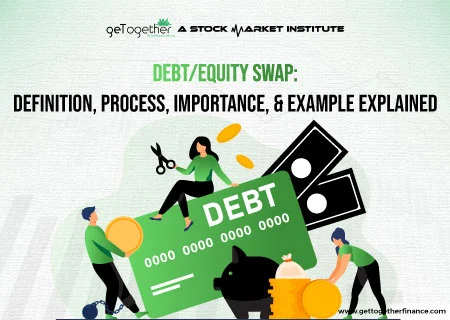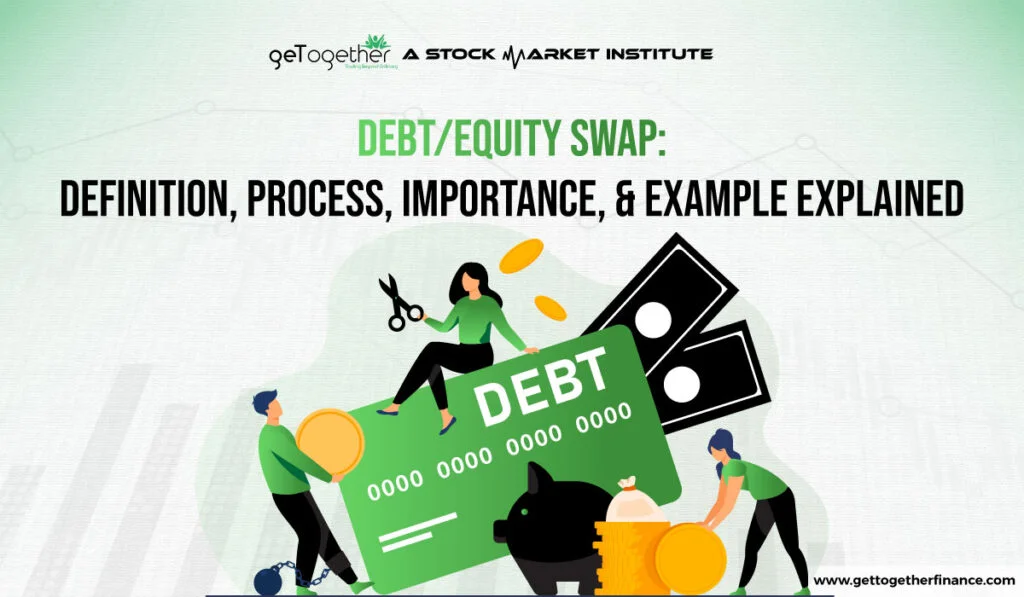Debt/Equity Swap: Definition, Process, Importance, & Example Explained


Table of Contents
ToggleOverview
Have you ever been stuck in a situation where you owe someone money, but simply can’t repay it in the traditional way? This can happen to both individuals and companies. In the finance world, there’s a clever solution called a Debt-to-equity swap that can help ease the burden.
This financial manoeuvre involves replacing debt obligations with ownership in a company. In this blog post, we’ll dive into the world of Debt-to-equity swaps, explaining how they work, the benefits and drawbacks for both lenders and borrowers and when they might be a good option.
What is a Debt/Equity Swap?

A Debt/equity swap is a financial transaction where a company’s debt is converted into equity shares. This is typically done to reduce the company’s debt burden and strengthen its balance sheet.
Companies usually consider a debt/equity swap when they are in serious financial trouble, such as not having enough cash, losing money, or experiencing a big drop in income. If the lender sees that the company probably won’t be able to repay its debt anytime soon, they might agree to exchange the debt for shares in the company. This means the lender becomes a part-owner of the company instead of being owed money.
However, the lender will only agree to this if they think cancelling the debt will help the company survive. If the lender believes the company is still likely to go bankrupt even after the debt is cancelled, they won’t see much benefit in taking shares in a failing company. This is because, if the company goes bankrupt, debt holders are paid first before equity holders.
How Does a Debt/Equity Swap Work?

A Debt-to-equity swap is essentially a trade-off. Instead of repaying a debt with cash, the borrower offers the lender a share of ownership in the company. Here let’s take a look at the debt/equity swap process:
The Process
- Financial Distress: Typically, a company facing financial difficulties, like high debt or liquidity problems, considers a Debt-to-equity swap.
- Negotiation: The company negotiates with its creditors or bondholders to propose the swap. The terms, including the equity-to-debt ratio, are discussed.
- Issuance of Equity: If the creditors agree, the company issues new equity shares to the creditors in exchange for a specified amount of debt cancellation.
- Ownership Change: The creditors become shareholders, owning a portion of the company proportional to the debt they converted.
A debt/equity swap lets companies, including the government, turn their debt into shares of the company, giving lenders ownership of the company instead of being paid back in cash.
For instance, if a company owes a bank ₹1 million. Instead of repaying the loan, it offers the bank 10% ownership of the company in exchange for cancelling the debt.
When a company is in a serious financial crisis or close to going bankrupt, it can’t pay back its debts. To fix its financial situation, one option is a debt/equity swap. This way, the company avoids immediate cash payments and gets a chance to recover financially.
Also Read: Hedging
Reasons for A Debt/Equity Swap

But the question is even with proper surveillance, strategic planning, and risk management, what are the reasons that can land a business to debt/equity swap? Let’s take a look into a few causes:
- Financial Distress: When a company is in financial trouble and cannot repay its debts, a debt/equity swap can provide relief. By converting debt into equity, the company reduces its immediate financial burden and improves its balance sheet.
- Avoiding Bankruptcy: A debt to equity swap can help a company avoid bankruptcy by reducing its debt obligations. This allows the company to continue operating and gives it a chance to turn its financial situation around.
- Improving Cash Flow: By eliminating the need to make interest and principal payments on the debt, the company can improve its cash flow. This freed-up cash can be used for essential business operations and growth initiatives.
- Debt Restructuring: It is a strategic way to restructure a company’s finances. Converting debt to equity can make the company more attractive to new investors and help it secure additional funding.
- Strengthening the Balance Sheet: Reducing debt through a debt/equity swap improves the company’s debt-to-equity ratio. This can enhance the company’s financial stability and make it more appealing to investors and creditors.
- Aligning Interests: Lenders who become equity holders have a vested interest in the company’s success. This alignment can lead to better cooperation between the company and its new shareholders, fostering a collaborative environment for business recovery.
- Increased Confidence: Successfully implementing a debt/equity swap can increase stakeholder confidence, including employees, customers, and suppliers. It shows that the company is taking proactive steps to address its financial challenges.
- Potential for Growth: Lenders who convert their debt into equity may benefit from the company’s future growth. If the company recovers and its stock value increases, these new shareholders can see significant returns on their investment.
Advantages & Disadvantages of A Debt/Equity Swap
A debt/equity swap offers major benefits when it comes to financial crises but also holds some major setbacks that a business needs to look at before opting for it as a financial strategy. Here we have a breakdown of the primary benefits and setbacks of debt to equity swap:
Advantages of a Debt/Equity Swap
A debt-equity swap offers distinct benefits for both the company and its creditors:
Advantages for the Company
- Improved Financial Flexibility: By converting debt into equity, the company can reduce its debt burden and improve its debt-to-equity ratio, enhancing its financial flexibility.
- Preservation of Credit Rating: A debt-equity swap can help a company avoid default, which could negatively impact its credit rating.
- Access to Equity Markets: The swap can introduce new equity investors to the company, potentially opening up opportunities for future equity financing.
- Potential for Future Growth: If the company’s fortunes improve, the converted debt holders (now equity holders) can benefit from increased share value.
Advantages for Creditors
- Potential for Higher Returns: If the company successfully turns around, equity holders can benefit from significant returns.
- Recovery of Investment: While not guaranteed, equity participation offers the potential to recover some or all of the original debt investment.
- Avoidance of Bankruptcy Costs: In some cases, a debt-equity swap can be a less costly alternative to bankruptcy proceedings for both the company and creditors.
Disadvantages of a Debt/Equity Swap
While debt-equity swaps can offer benefits, they also come with potential drawbacks. Here let’s take a look at the setbacks of debt-to-equity swap:
Disadvantages for the Company
- Dilution of Ownership: Converting debt to equity results in a dilution of ownership for existing shareholders.
- Loss of Control: Increased equity ownership by creditors can potentially lead to a loss of control for the company’s management.
- Negative Market Perception: A debt-equity swap can be perceived negatively by investors, potentially impacting the company’s stock price.
Disadvantages for Creditors
- Valuation Challenges: Determining the fair value of the equity to be received in exchange for debt can be complex and subject to negotiation.
- Investment Risk: As equity holders, creditors assume the risk of the company’s future performance, which could lead to losses.
- Delayed Recovery: Unlike debt, equity typically offers no guaranteed repayment, potentially delaying the recovery of the original investment.
Real-Life Example of Debt/Equity Swap

In 2019, the struggling Indian airline Jet Airways underwent a Debt-to-equity swap as part of its financial restructuring efforts. The airline had accumulated over ₹7,000 crore in debt from various lenders, including banks and aircraft lessors.
As part of the restructuring plan, the lenders, led by the State Bank of India, agreed to convert a portion of Jet’s debt into equity shares, taking a 50.1% controlling stake in the airline. This Debt-to-equity swap helped Jet Airways reduce its overall debt burden significantly, from over ₹7,000 crore to around ₹3,000 crore, improving the airline’s financial position.
However, the ownership change resulted in the previous promoters, the Goyal family, losing control of Jet Airways. Despite the Debt-to-equity swap, Jet Airways ultimately ceased operations in April 2019 due to continued financial troubles, underscoring the challenges the company faced in reviving its business.
In A Nutshell
In conclusion, a debt/equity swap can be considered as an additional lifeline for companies in financial trouble. It allows them to convert their debt into shares of the company, reducing their debt burden and improving cash flow, giving them a chance to recover and grow. However, there are downsides too. Current owners may end up with less control over the company, and the process can be complicated and time-consuming. Debt/equity swap also leaves no guarantee that the company will turn around even after the swap. It can be a smart move if done right, but it’s important to consider the potential risks and benefits carefully.
FAQs
How does a Debt-to-equity swap affect the company’s earnings per share (EPS)?
EPS may decrease after the swap, as the company’s profits are now divided among a larger number of shares.
Can Debt-to-equity swaps affect a company’s credit rating?
Yes, reducing debt can improve the company’s creditworthiness and credit rating, making it easier to access financing in the future.
Can Debt-to-equity swaps help attract foreign investment?
Yes, they can make the company more attractive to foreign investors by reducing its debt levels and increasing its equity base.
Are there any alternatives to Debt-to-equity swaps for companies facing debt problems?
Yes, other options include debt restructuring, asset sales, or seeking additional financing through equity or debt markets.



 Facebook
Facebook Instagram
Instagram Youtube
Youtube
